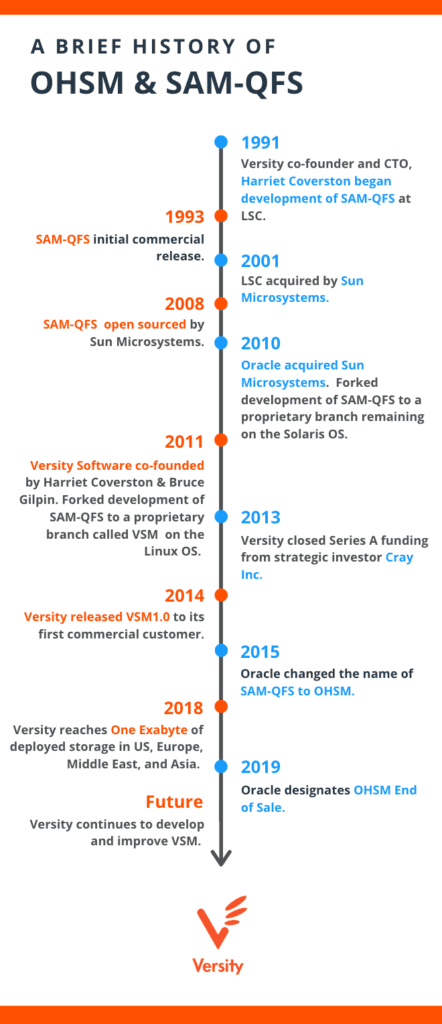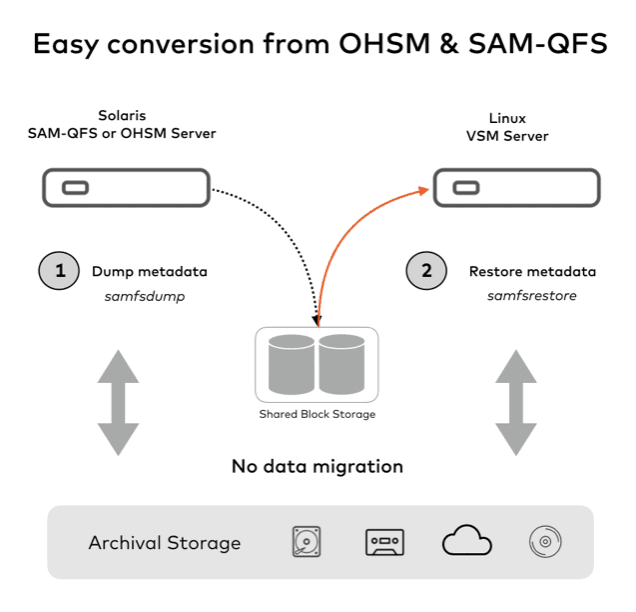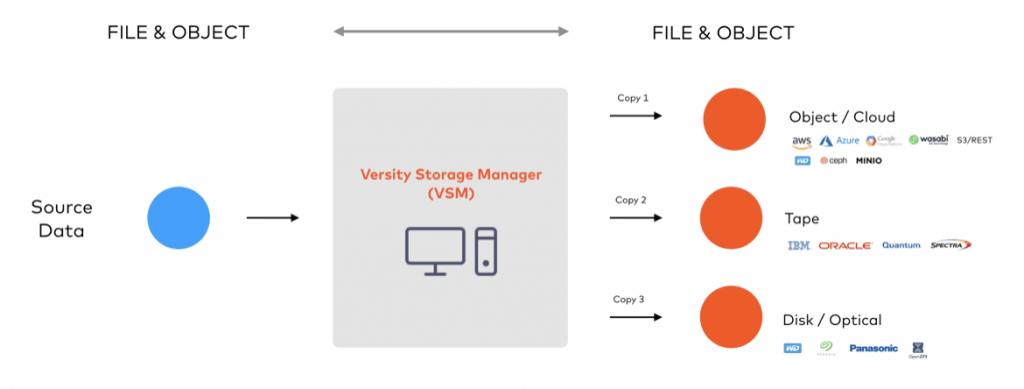Last week, Oracle officially announced End of Sale for OHSM at the 2019 DLR HSM User Conference in Neustrelitz, Germany so we thought it would be a good time to look back at the history behind this iconic archival storage product and then discuss what this announcement means for Oracle sites that currently depend on OHSM or SAM-QFS technology. In addition, we will discuss what this change means for the broader archival storage market.

Prior to introducing the name Oracle Hierarchical Storage Manager or OHSM, this product was historically known as SAM-QFS which stood for Storage and Archive Manager – Quick File System. SAM-QFS was created in the early 1990’s by a private company called Large Storage Configurations (LSC) under the technical direction of Versity co-founder and CTO, Harriet Coverston.
LSC released the first commercial version of SAM-QFS in 1993. Their unique archiving product quickly gained a loyal following with deployments in large commercial, scientific, and government sites all over the world. In 2001, LSC was acquired by Sun Microsystems. SAM-QFS had been on the Solaris operating system since 1996 and at the time Sun purchased LSC, the Solaris OS was at or near its peak in terms of server OS market share.
With access to Sun’s sales and distribution channels, the SAM-QFS deployment footprint accelerated worldwide as new features and capabilities were added to the product. Sun was able to offer a compelling hardware and software package including servers, the Solaris OS, shared storage, and StorageTek tape libraries all in one package.
On January 27, 2010, Oracle completed its acquisition of Sun Microsystems. At that time, the Solaris server market share had been in a free fall for eight years and it was clear that SAM-QFS would need to move to the Linux OS in order to remain vibrant.
In 2011 Harriet Coverston and I co-founded Versity Software and immediately began working to port SAM-QFS to Linux. Thanks to the fact that Sun open sourced SAM-QFS in 2008, we were able to incorporate the open source SAM-QFS technology into our product under the terms of Sun’s open source license. Like Oracle, we forked from the Sun open source but unlike Oracle, we chose to develop our product on the Linux operating system. We named our product Versity Storage Manager (VSM) and it has been under continuous and active development for the past five years. During this time period we have released more than 60 software updates and upgrades.
What does this mean for Oracle sites?
Oracle’s End of Sale announcement means that the installed base of OHSM customers have a fairly short period of time to move to a different archive management solution. Fortunately, we offer a very convenient path forward with the highest possible level of continuity. Because of the common code base we share with OHSM, and because of the technical leadership in our company, we are extremely well positioned to support OHSM archive sites.
Switching from OHSM to VSM is a straightforward process. The metadata and data formats between the two products are compatible so it is possible to simply utilize the filesystem dump utility to create a dump file from OHSM, and then use the samfsrestore command to restore the metadata to VSM. After the restore procedure, the VSM server is able to read all previously archived data, and is able to write new data.

We have published a conversion guide providing detailed instructions on how to accomplish the conversion.
Why Versity?
In the past five years, Versity has successfully deployed archive management systems for high profile customers around the world. The company is actively developing and improving VSM with an average software release rate of once per month.
Switching to Versity is a quick and easy solution to the near term OHSM problem. It also makes sense in terms of keeping options open for future decisions that may involve larger pieces of your infrastructure. While dozens of improvements, enhancements and bug fixes have been implemented in VSM, there are several specific areas of functionality that have been added that were never fully developed in OHSM. The two most visible enhancements center on enabling cloud for both ingest and archiving. VSM supports a scalable object storage interface at the front end of the archive manager allowing VSM to ingest S3 compliant object data. VSM also supports a scalable S3 object storage interface on the back end of the archival system allowing VSM to move data at high bandwidth to private or public cloud storage systems. Whether your long term archival storage remains on tape, or begins to incorporate public or private cloud storage, or even optical storage, VSM will meet your needs.

What this means for the archival storage market
With the End of Sale announcement for OHSM, we are seeing a visible sign of consolidation in the archival storage software market and we believe this trend will accelerate over the course of the next five years.
While some will choose to interpret the OHSM announcement as a sign that the frequently repeated but never realized “end of tape” myth is finally becoming a reality, our take on this development is different.
The large archive software and hardware market is maturing and like in any maturing market segment, there is usually consolidation among the suppliers as customers identify and support a winner that offers the most innovative and competitive solution. Almost every segment of the technology market eventually consolidates around a clear winner and that winner typically achieves something close to 80% market share.
The process of consolidating around a winner in the archival software market has taken an extended period of time to play out due primarily to two factors. First, is the high cost of switching to a new solution, and second is the fact that there has not historically been a clearly superior, modern, technically advanced alternative. Each of the primary products in the sector are more than ten years old, and each has significant technical deficiencies. There is no clear market leader because there has been no clear technical leader.
We believe that the period of stagnation in this market sector is coming to an end. Public cloud storage options for smaller archival sites under several Petabytes in size, have placed pressure on some of the established brands that historically enjoyed a large number of deployments in the small to medium sized segment of the market. This pressure has resulted in less R&D support for new and existing features.
On a more positive note, the large archive segment of the market comprised of sites managing greater than 5 Petabytes of data has been very healthy. Large archive sites have a very clear economic and performance incentive to operate on premise private cloud or tape archive systems, or hybrid private cloud and tape solutions. Large archive sites are also rapidly expanding capacity as the need for low cost mass data storage services grows within their organizations.
Versity is in its fifth year of double-digit percentage growth and has begun beta phase trials of the new VSM2 large archive solution featuring the ScoutFS filesystem and the ScoutAM archive manager. VSM2 is positioned to leapfrog existing solutions in terms of scalability, efficiency, and usability. Versity’s mission is to develop the world’s most advanced large archive solution in order to meet the needs of the most demanding archive sites in the world and to present consumers of this technology with a clearly superior solution.
My prediction is that there will be more consolidation in both the hardware, and software side of the large archive market and an 80% market share “winner” will emerge in both segments within the next 3-5 years. This is a normal and healthy evolutionary trend for any technology market and should lead to lower costs and superior technology for customers.


